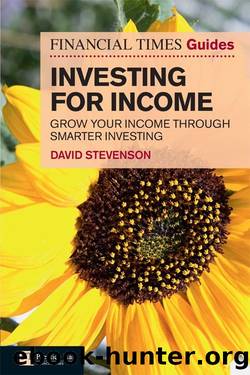FT Guide to Investing for Income: Grow Your Income Through Smarter Investing (The FT Guides) by David Stevenson

Author:David Stevenson [Stevenson, David]
Language: eng
Format: epub
ISBN: 9780273776383
Publisher: Pearson Education Limited
Published: 2012-09-25T23:00:00+00:00
Over the next five years our dividend fund must pay out £2.5 million in interest on the loans and £2.8 million in dividends to the income shares â a total of £5.3 million paid from the dividend income of £7.5 million (any remaining income is paid in fund management costs and fees or kept in reserve).
In five yearsâ time if the fund does indeed produce a capital return of 5% per annum, our £191 million is used to pay back the £66.6 million owed to the zero dividend capital shares, the £40 million owed to the income shares, and the £50 million loan. The remaining £34 million is kept by the capital shareholders, who have made a massive return on their initial £10 million investment.
But what happens if returns are nowhere near 5% per annum? What happens if the capital doesnât grow at all? If our £150 million fund is still worth £150 million in five yearsâ time? Our £50 million loan must be paid back first, and then our zero dividend shareholders â leaving just £33.33 million for our income shareholders (remember they invested £40 million) and nothing for the capital shareholders. And if the shares actually decreased in value, our income shareholders would be even harder hit, with losses possibly extending all the way into the zero dividend class.
Falling stockmarkets spell unmitigated catastrophe for nearly all shareholders â remember that the loan had to be repaid before all other classes and even relatively safe classes of shares could find their final payout jeopardised. And disaster did indeed strike in the years 2000 to 2002. Equity markets across the world dived in value as a consequence of the âdot.conâ fiasco and suddenly equity income funds found themselves in a massive storm, as split cap managers were forced to sell their holdings, pushing values down to even lower levels. The following box explains in a little more detail how this fiasco was made worse by the structure of these funds, but the end result was nearly terminal for this very specialised sector. Many normally conservatively inclined investors who had invested huge sums in the income and zero dividend classes, expecting rock solid returns, suddenly found the payments stopped and the capital principal threatened. Many split capital funds closed, a huge investigation into the sector was launched, and compensation was paid out in the more extreme cases. But the sector didnât completely die â a small number of split capital funds did survive and in Tables 5.9 and 5.10 we list both the surviving zero dividend share classes on offer (with gross redemption yields based on 0% growth in the underlying basket of equities) as well as the much smaller pool of income shares (with running yield).
Download
This site does not store any files on its server. We only index and link to content provided by other sites. Please contact the content providers to delete copyright contents if any and email us, we'll remove relevant links or contents immediately.
| Analysis & Strategy | Bonds |
| Commodities | Derivatives |
| Futures | Introduction |
| Mutual Funds | Online Trading |
| Options | Portfolio Management |
| Real Estate | Stocks |
Pioneering Portfolio Management by David F. Swensen(5606)
Rich Dad Poor Dad by Robert T. Kiyosaki(5149)
How To Win Friends and Influence People by Dale Carnegie(3772)
The Money Culture by Michael Lewis(3284)
The Dhandho Investor by Mohnish Pabrai(3169)
The Wisdom of Finance by Mihir Desai(3079)
Liar's Poker by Michael Lewis(2812)
The Intelligent Investor by Benjamin Graham Jason Zweig(2597)
The ONE Thing by Gary Keller(2519)
Mastering Bitcoin: Programming the Open Blockchain by Andreas M. Antonopoulos(2512)
Investing For Dummies by Eric Tyson(2470)
How to Day Trade for a Living: Tools, Tactics, Money Management, Discipline and Trading Psychology by Andrew Aziz(2445)
How to Win Friends and Influence People by Dale Carnegie(2435)
Rich Dad Poor Dad: What The Rich Teach Their Kids About Money - That The Poor And Middle Class Do Not! by Robert T. Kiyosaki(2434)
Fooled by Randomness: The Hidden Role of Chance in Life and in the Markets by Nassim Nicholas Taleb(2413)
Zero Hour by Harry S. Dent Jr. & Andrew Pancholi(2246)
Market Wizards by Jack D. Schwager(2164)
Rich Dad's Guide to Investing by Robert T. Kiyosaki(2111)
How to Pay Zero Taxes, 2018 by Jeff A. Schnepper(2100)
